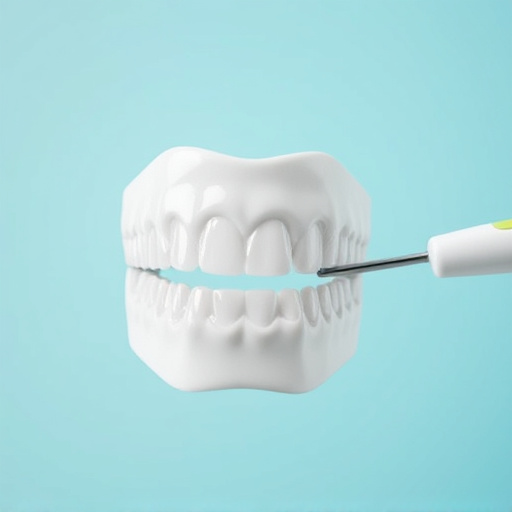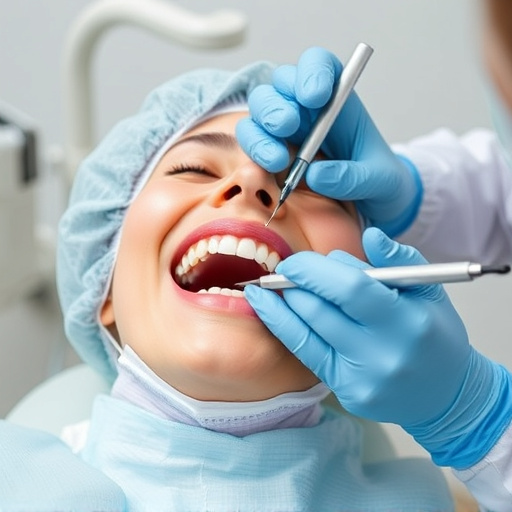Unveiling CEREC Dental Technology: Immediate Crown Placement Explained
CEREC dental technology revolutionizes tooth repair with same-day, precise, and aesthetically pleasi…….
In the ever-evolving landscape of dental care, CEREC (Computer-Aided Design/Computer-Aided Manufacturing) dental technology has emerged as a game-changer. This innovative system promises faster, more precise, and esthetically pleasing dental restorations, transforming traditional dental practices. The article delves into the intricacies of CEREC technology, exploring its impact on global oral healthcare, economic implications, technological advancements, regulatory frameworks, challenges, and future potential. By examining these aspects, we aim to provide a comprehensive understanding of how CEREC is redefining dental treatments worldwide.
Definition: CEREC dental technology is a revolutionary system that combines computer-aided design (CAD) and computer-aided manufacturing (CAM) to create custom dental restorations, such as crowns, bridges, and implants, in a single visit. This advanced approach streamlines the traditional dental process, eliminating the need for multiple appointments and laborious hand crafting.
Core Components:
Historical Context: The inception of CEREC technology dates back to the late 20th century when computerization in dentistry began gaining traction. Early developments focused on simplifying dental design and manufacturing processes. Over time, advancements in scanner technology, software algorithms, and material science have refined CEREC, making it a global standard for efficient and precise dental care.
Significance:
CEREC dental technology has left a significant global footprint, with its adoption spreading across continents. Key trends shaping its trajectory include:
Regional Adoption Rates: According to market research, North America and Europe have been early adopters of CEREC technology, with high acceptance rates. Asia-Pacific is experiencing rapid growth, driven by increasing dental tourism and rising disposable incomes. Latin America and the Middle East are also witnessing growing interest in CEREC due to its cost-effectiveness and improved treatment outcomes.
Digital Transformation in Dentistry: The global shift towards digital dentistry, fueled by advancements in computer technology and internet connectivity, has significantly influenced the adoption of CEREC. Digital imaging and design tools have become integral components of modern dental practices worldwide.
Teledentistry and Remote Care: The COVID-19 pandemic accelerated the trend of tele dentistry, where CEREC technology enables remote consultations and treatment planning. This allows patients in remote areas to access advanced dental care without travel.
Personalized Medicine: There is a growing emphasis on personalized dental care, and CEREC aligns with this trend by allowing for customized, patient-specific restorations.
The economic aspects of CEREC dental technology are multifaceted, impacting both dental practices and patients.
Market Dynamics:
Investment Patterns:
Economic Impact on Dental Practices:
Continuous technological advancements have pushed the boundaries of what CEREC can achieve, driving innovation and improvement in the field.
Regulatory frameworks play a vital role in governing the use of CEREC dental technology to ensure safety, quality, and patient protection.
Despite its numerous advantages, CEREC dental technology faces several challenges and criticisms that must be addressed for widespread adoption.
Strategies to Overcome Challenges:
A small dental clinic in a rural area of India adopted CEREC technology to improve access to quality dental care for underserved communities. By implementing CEREC, the clinic could offer same-day crowns and bridges, reducing treatment times from weeks to hours. This not only improved patient satisfaction but also encouraged more people to seek dental treatment. The clinic’s success led to increased patient referrals and improved oral health outcomes in the region.
A U.S. military dental hospital integrated CEREC technology into its practice to streamline treatments for active-duty service members. The system enabled faster, more accurate restorations, reducing chair time and improving patient flow. Additionally, the hospital’s ability to create custom, high-quality crowns and bridges enhanced the overall aesthetic results, leading to higher patient satisfaction ratings.
A private dental practice in Canada utilized CEREC technology as a strategic tool for business growth. By offering same-day restorations, the practice attracted new patients and retained existing ones. The efficiency of CEREC allowed them to accommodate more patients without expanding their team significantly. This case illustrates how CEREC can be a powerful asset for modern dental practices aiming to stay competitive in a crowded market.
The future of CEREC dental technology looks promising, with several growth areas and emerging trends on the horizon.
CEREC dental technology has emerged as a transformative force in the field of dentistry, offering unprecedented efficiency, precision, and aesthetic improvements in dental care. Its global impact is evident in the widespread adoption across regions, driven by technological advancements and evolving patient expectations. As the market continues to grow and mature, CEREC will play a pivotal role in shaping the future of oral healthcare worldwide.
Q: How does CEREC differ from traditional dental restoration methods?
A: CEREC utilizes computer-aided design and manufacturing to create custom dental restorations in a single visit, eliminating the need for temporary crowns or multiple appointments. Traditional methods often involve manual crafting by dental technicians, which can be time-consuming and less precise.
Q: What are the benefits of using CEREC technology for dentists?
A: For dentists, CEREC offers increased efficiency, allowing them to provide faster treatments and improve patient flow. It enhances accuracy in restoration design, leading to better long-term outcomes. Additionally, the aesthetic appeal of CEREC restorations can boost patient satisfaction and build a positive reputation for dental practices.
Q: Can CEREC be used for all types of dental restorations?
A: While CEREC is versatile, it may not be suitable for every type of restoration. Complex cases, such as extensive tooth reconstruction or implants with unique requirements, might still necessitate traditional laboratory techniques. However, for crowns, bridges, and inlays/onlays, CEREC provides a highly effective solution.
Q: How does the cost of CEREC technology compare to traditional dental equipment?
A: The initial investment in CEREC systems is significantly higher than traditional dental equipment due to the advanced technology involved. However, long-term savings can be realized through reduced remakes, less chair time, and improved patient retention. Many dental practices justify the cost based on these potential financial benefits.
Q: Are there any safety concerns associated with CEREC?
A: CEREC systems are designed with safety in mind, adhering to strict regulatory standards. The use of computer-aided design ensures precise measurements and material handling, minimizing potential risks. Regular maintenance and proper training for dental professionals further reduce any perceived safety risks.

CEREC dental technology revolutionizes tooth repair with same-day, precise, and aesthetically pleasi…….

CEREC dental technology streamlines crown repairs with its same-day solution. Dentists use intraoral…….

CEREC dental technology, leveraging CAD/3D printing, revolutionizes modern dentistry by offering sam…….